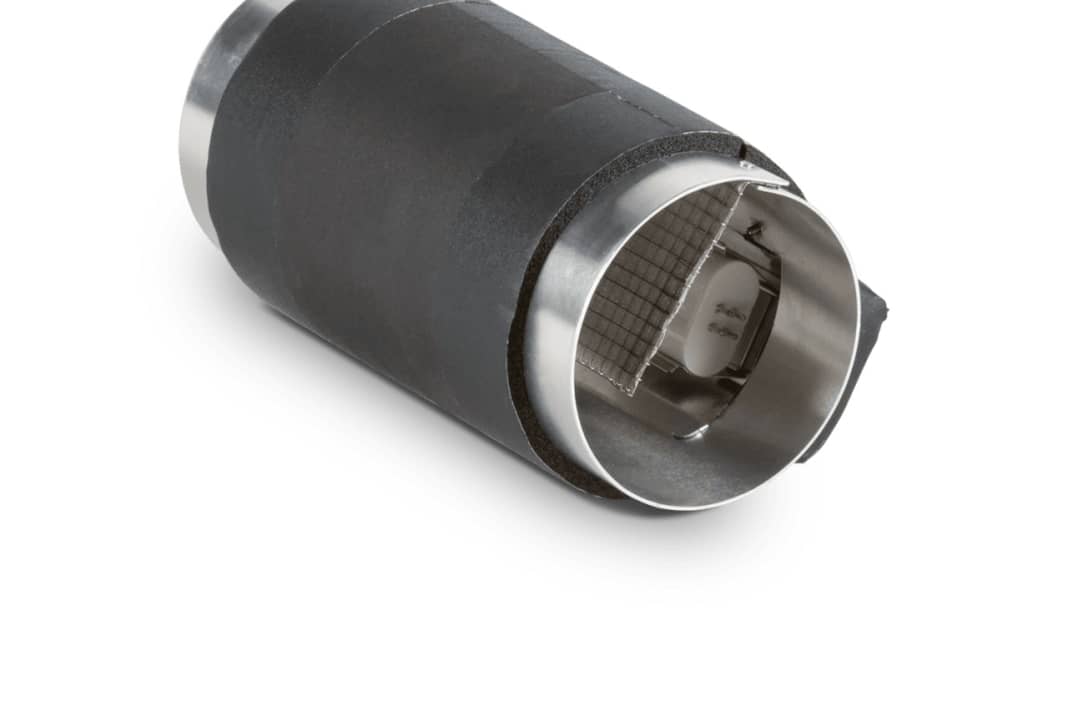Cooling for the bunk and cabin: How to retrofit an air conditioning system on a sailing yacht
Johannes Erdmann
· 13.09.2023
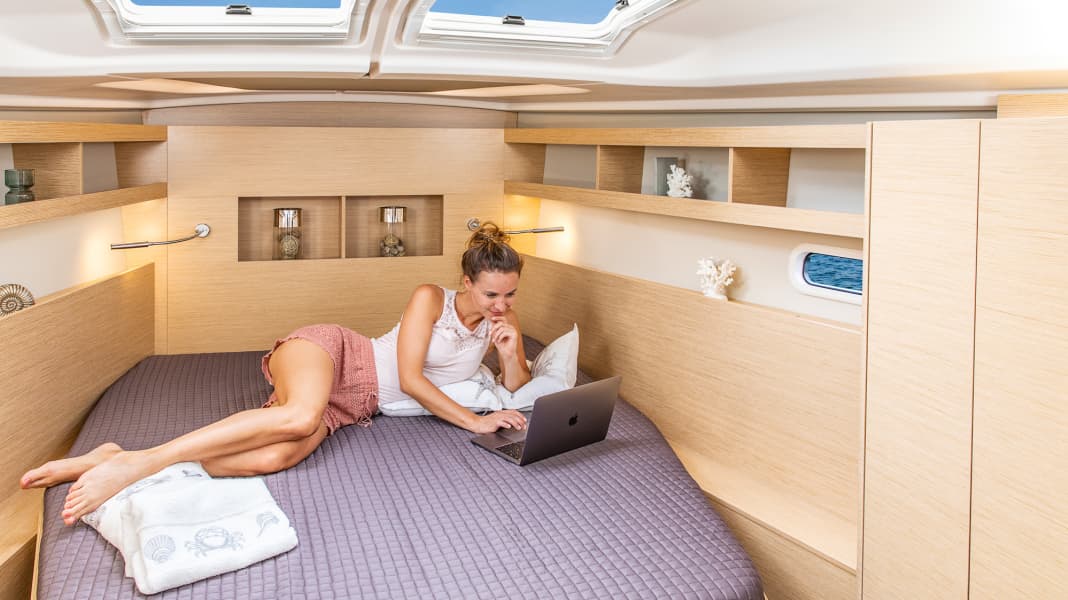
In this article:
Drenched in sweat, the crew rolls from side to side. It is hot. The air below deck is almost stagnant. Even though the temperature outside the boat has cooled down a little in the meantime, the interior continues to glow even hours after sunset because the hull has heated up in the sun during the day. There is no exchange of air to cool it down more quickly. The mosquito screens in the open hatches muffle any additional breeze, and the small fan above the bunk provides little relief. Even the hope of an end to the night's torment is in vain - because when the night is over, the sun rises in the sky.
Lying awake in the bunk because of the heat - a situation that every sailor knows. My family and I on our Fountaine Pajot Mahé 36 catamaran, which is moored in Greece, are no exception. While a little wind blows through the cabins at anchor, it's almost unbearable below deck in the harbour in summer. But such scenes are not only familiar in the Mediterranean. With climate change, it can also become increasingly hot in the Baltic Sea in midsummer.
Air conditioning is often still a luxury on sailing yachts
In the cold, it's simple: putting on more clothes helps. In the heat, however, the options are limited. In southern countries, people come to terms with the high temperatures by resting at lunchtime. Anything that isn't done by late morning there has to wait until the evening when it gets cooler. But once the boat has heated up during the day, it doesn't get really cool below deck at night either. It's almost impossible to relax.
How nice it would be to have air conditioning on board. A thought that surprisingly few sailors have, because the appliances are still seen as a luxury that you can do without.
Around 30 years ago, the conventional wisdom in this country was the same when it came to air conditioning in cars. A luxury or even "a trend that won't catch on", it was said at the time. Today, no car is sold without air conditioning. Those who have one arrive at their destination more relaxed after long car journeys - and air conditioning units are also increasingly common on the walls of houses. Not for the whole home, as in the USA. But at least in the bedroom, more and more people are treating themselves to this now affordable luxury, which ensures a good night's sleep in a well-tempered room.
Installation of an air conditioning system at the shipyard is often very expensive
However, this trend has not yet arrived on yachts. Shipyards only install them on boats travelling to the Mediterranean or the Caribbean. For occasional use, "the climate" is simply too expensive for most sailors. For the currently smallest sister ship of our catamaran, an Isla 40, for example, the air conditioning option costs around 26,000 euros. The seemingly high price is put into perspective a little when you consider that three air conditioning units are installed: two in the hulls and one in the saloon. A monohull of the same size often manages with two chillers. Nevertheless: a high additional investment.
Because air conditioning can only be used in harbour using shore power, many shipyards consider it obligatory to order a diesel generator, which in the case of the 40-foot catamaran adds almost 24,000 euros to the price. This means that the air conditioning option accounts for a good ten per cent of the Isla 40's base price. A sum for which most sailors are prepared to sweat. "It's only a few days a year when it's really hot ..." is usually the argument.
The first owners of the Mahé 36 also decided not to install air conditioning at the time. Ex shipyard, the boat would otherwise have been equipped with two air conditioning units with a capacity of 8,000 BTU each in the aft cabins and a module of 12,000 BTU in the saloon. The BTU measurement stands for British Thermal Unit and defines the thermal energy required to heat one British pound of water by one degree Fahrenheit.
The economy option: Cool only the saloon and one cabin with air conditioning
However, it is not always necessary to keep the entire boat at a comfortable temperature. An economy option is often sufficient to cool the saloon and a sleeping cabin efficiently, at least when the outside temperature is extremely high, so that you can relax at night.
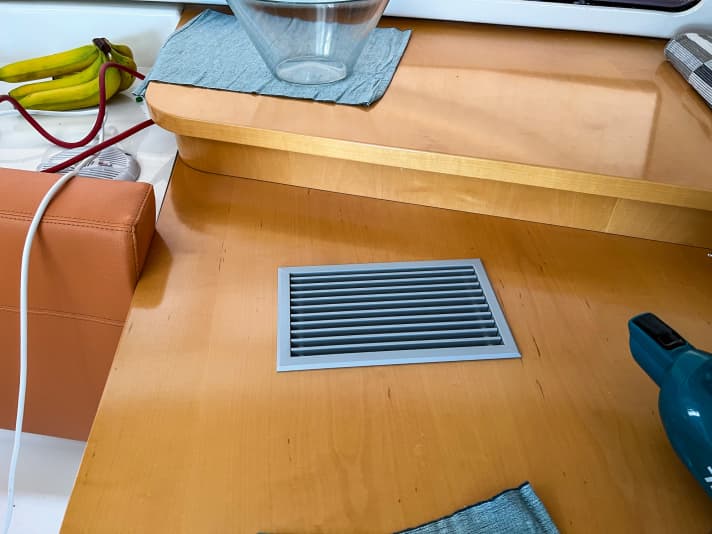
This is why the Mahé 36 was equipped with a retrofitted Dometic Turbo DTG16 with 16,000 BTU. With the new model, the global market leader in air conditioning technology on boats has developed a particularly energy-saving and extremely quiet device that can also be used effectively for heating. The complete set for self-installation with on-board aperture, cold air hoses, outlets and digital touch control panel costs 6,638 euros.
Retrofitting is generally not difficult, but depending on the type of boat, it can sometimes be a little laborious because the cold air ducts have to be pulled through the entire ship in the cavities behind the interior fittings or between the inner and outer shells. To do this, it is necessary to saw very large holes with diameters of up to 24 centimetres in the bulkheads.
Air conditioning systems are also useful for drying
For most northern Europeans who didn't grow up with air conditioning (AC) in their homes, "air conditioning" means just one thing: cold air. But air conditioning has many more functions. It can - especially in areas with high humidity - effectively protect the boat from mould and sparks. The AC unit does not have to run all summer, as is common in many North American harbours. It is often sufficient to dry the boat completely for a day after use with the help of the air conditioning unit, bring the humidity level in the cabins below 50 per cent and then keep it low with chemical dehumidifiers during the absence. If the summer is rather rainy - as it has been this year - then the drying function is a real blessing to get the humidity under control.
And when it gets particularly cold, the air conditioning system can be used as a water-to-air heat pump for extremely energy-efficient heating. This is also common practice in southern countries. There, there is no "real" heating at all and the air conditioning unit is simply switched to heating mode. Of course, there are limits to the possibilities and it is not suitable for wintering on board. But during the transitional periods in spring and autumn, it can effectively ensure that the cabin remains cosy and warm and does not become a cold stalactite cave.
Purely a matter of habit
Too cold, too loud, too much of an energy guzzler - not everyone likes air conditioning. But in many cases, the reasons for dislike and prejudice simply lie in incorrect use. Anyone who has to freeze through an air conditioning unit has simply set it too cold. The purpose of an air conditioning system is to reduce extreme heat peaks, not to turn the cabin into an icebox. The aim is to achieve a pleasant room temperature - the optimum difference between the inside and outside temperature is around six degrees Celsius.
If you are annoyed by the constant whirring or the cold wind, you should select a lower fan level or arrange the air vents differently, as modern air conditioning systems are barely audible when set correctly. Dometic offers a sound cover to halve the background noise of the appliance, which is often installed under saloon benches.
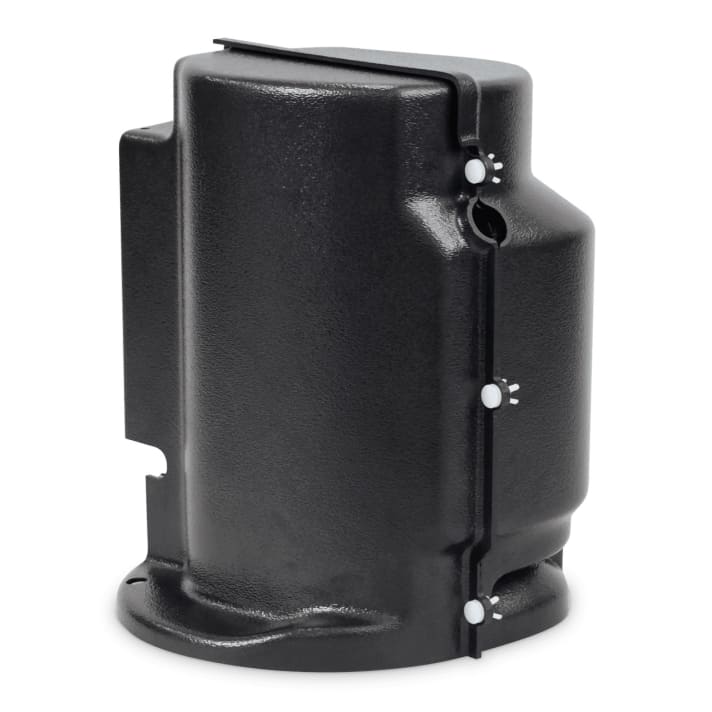
Shore power is often necessary
There are few chillers that can be operated directly from the 12-volt on-board power supply. With a low output of 6,000 BTU, they are only suitable for cooling a small cabin. All other models require a voltage of 230 volts. In normal cooling mode, the DTG16 from Dometic requires a maximum of 5.5 amps of power, and seven amps in heating mode. Around 30 per cent less than previous models. The highest current peaks occur when the air conditioning systems start up. During use and in an already cool interior, the average consumption is significantly lower, as the air conditioning system works in recirculation mode, meaning it does not draw in warm outside air, but only regulates the already cooler air in the saloon in an energy-efficient manner.
An additional component, the Dometic Smartstart module (approx. 870 euros), also makes it possible to cut the high current peaks and operate the AC system on weaker fused bridges or with a mobile generator. This even makes it possible to run the air conditioning unit via the inverter and the battery bank. Not permanently, but at least for two hours, so that the boat, which has been heated up during the day, cools down at night. Once all the cabins and surfaces are cool, all you need is an open hatch to sleep in a good climate.
Better efficiency with permanently installed air conditioning
The main advantage of a permanently installed air conditioning system over a mobile one is that it is much more efficient due to the water cooling and therefore has a higher cooling capacity with lower consumption. There is also no need to route an exhaust air hose through a hatch to the outside; the heat is dissipated via the water cooling system. One disadvantage is that the system can only be used in the water. When the boat is on land in the boatyard, the unit is not working.
What's more, even a modern air conditioning system like the Dometic DTG16 cannot perform miracles, as the working environment on yachts is more than inhospitable because most ships - apart from the sandwich deck - are not insulated against heat at all and the windows and hatches are single-glazed. Even if the cabin in the centre reaches comfortable temperatures, the hull can be up to ten degrees hotter. Nevertheless, it makes a huge difference whether it is 26 degrees on average in the cabin - or well over 30 degrees.
Retrofit air conditioning- All work steps at a glance
Steps 1 to 7: Preparatory work for assembly
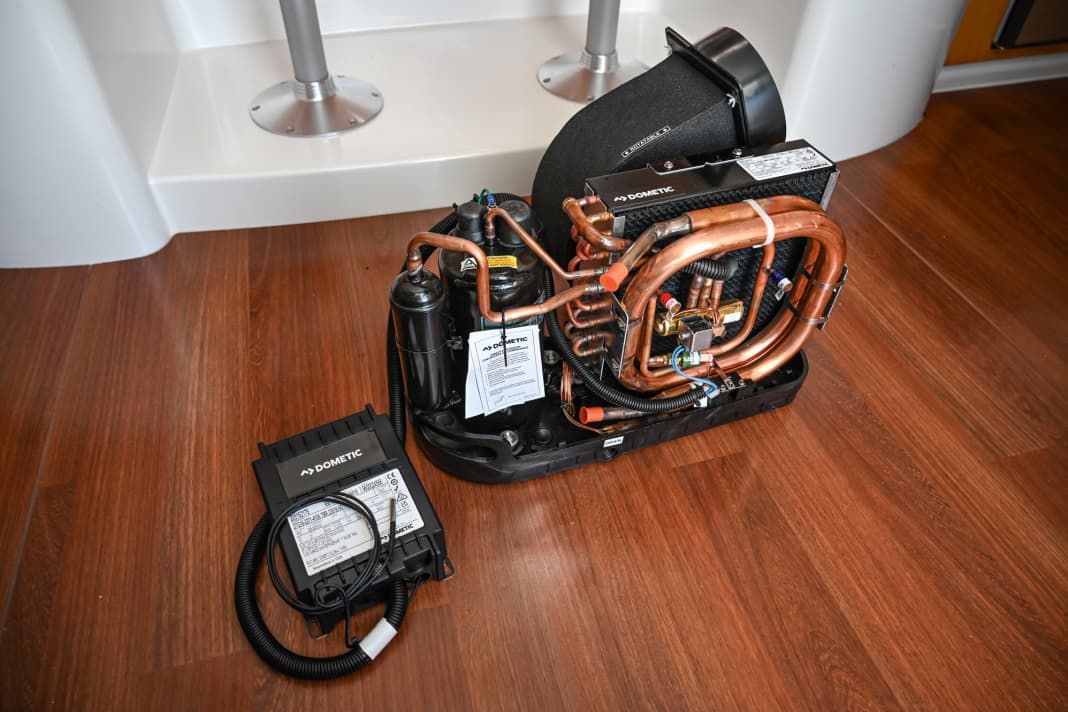





Steps 8 to 14: Installing the individual modules
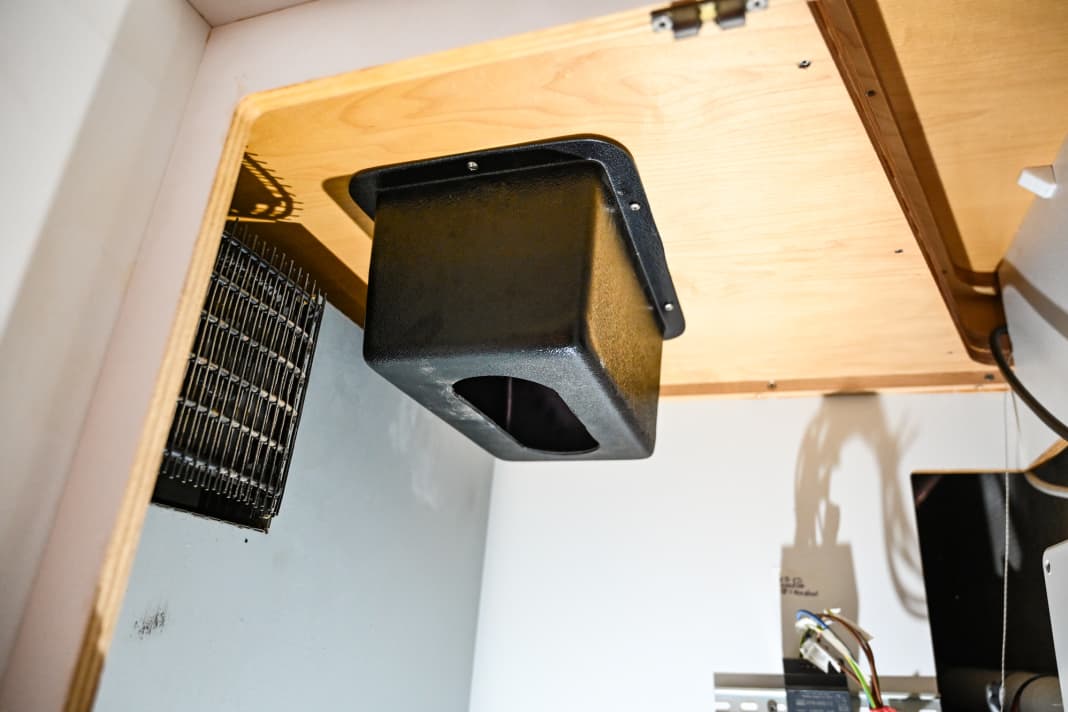





Steps 15 to 23: Connecting the cold air hoses and the power supply
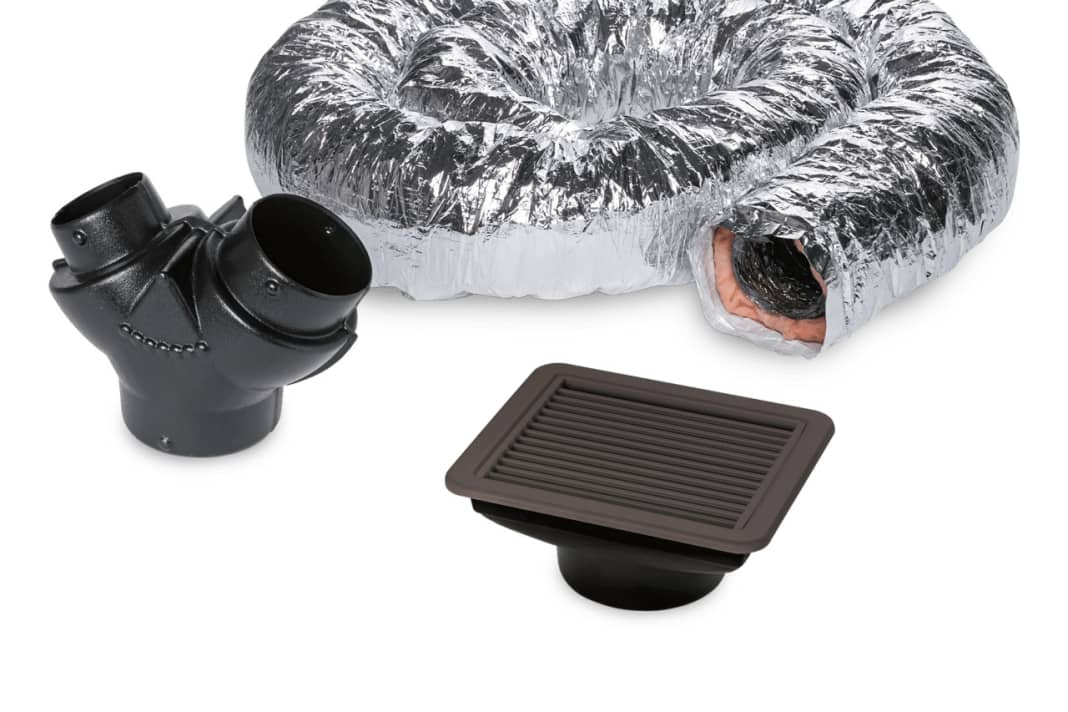





Steps 24 to 26: Commissioning and test run
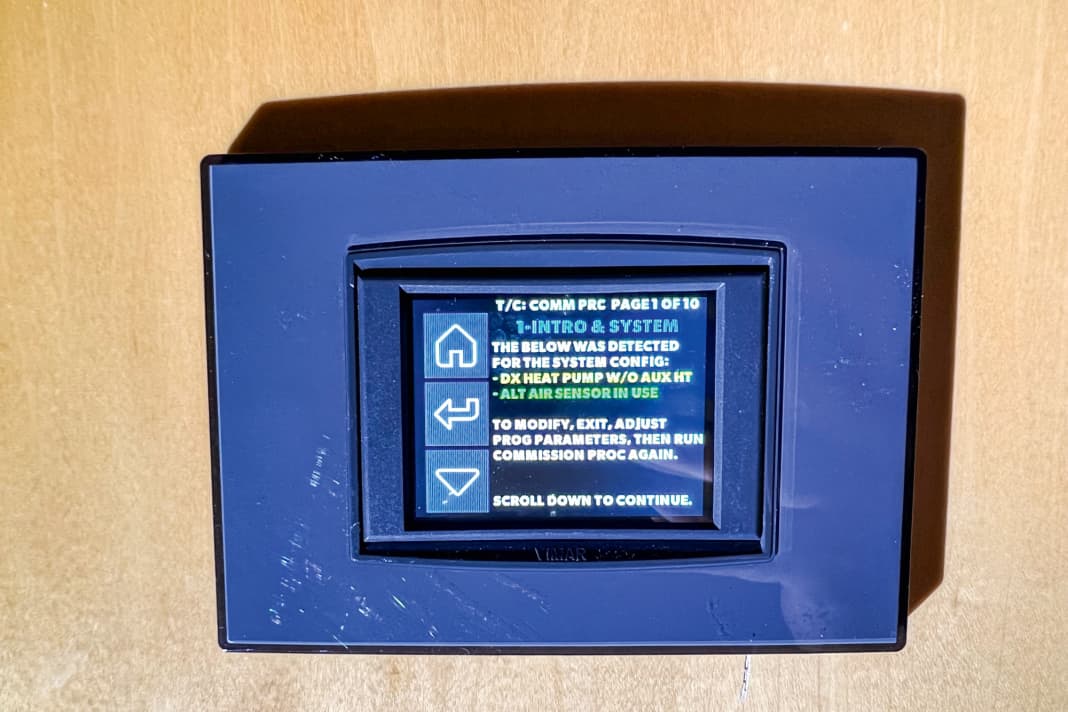





Detailed photos of the chiller
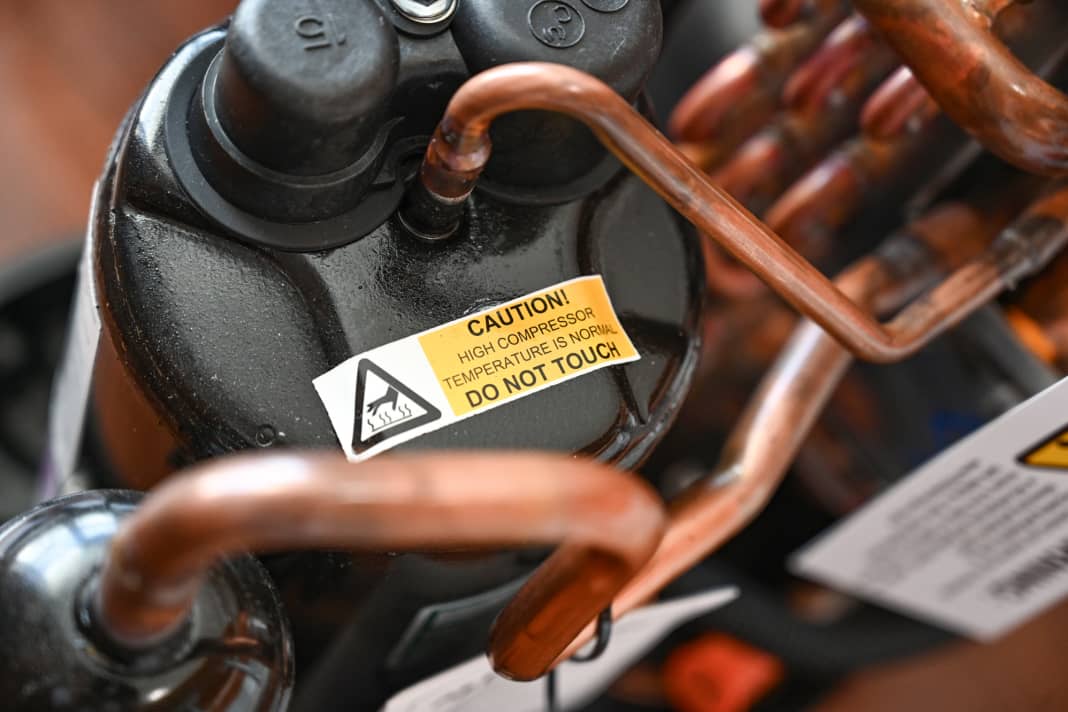





Optional accessories for the air conditioning system on board
